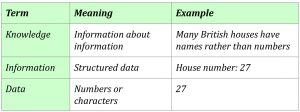The text on this page and successive pages comes from the Knowledge Modelling Handbook, by Gordon Rugg & Sue Gerrard.
WHAT IS KNOWLEDGE MODELLING?
This book is about methods for handling knowledge, as opposed to information or data.
In the book, we follow a widely used model in defining these terms as shown in the table below. The model is often referred to as the DIKW pyramid; Data, Information, Knowledge and Wisdom. (Wisdom is sometimes defined as knowledge about knowledge, but there’s debate about the definition so we’ve omitted it from the table.)

In brief, anything in a database or a spreadsheet is likely to be data or information. Computers are very good at dealing with data and information, but are poor at handling knowledge. Traditional approaches to handling knowledge, as in fields such as philosophy and logic, only deal with some aspects of it. More recently, new insights about knowledge have emerged from various fields, notably psychology and computing. Our work aims to bring all these insights together into a complete model of what knowledge is, and of how best to handle it.
Over the past three decades, we’ve pulled together, from a diverse range of fields, methods for finding out what knowledge people have, and how they configure it. We call the methods knowledge modelling, to distinguish them from knowledge management.
This book is a handbook of knowledge modelling, as opposed to an overview for general readers. It can be read on its own, but it’s intended primarily for people who already have an overview of knowledge modelling, who want a text that can be used for reference, and that shows examples of concepts. Part 1 provides a brief overview for any readers unfamiliar with the field.
WHY KNOWLEDGE IS DIFFICULT
In the early days of information technology (IT), it was assumed that all knowledge was explicit and rational, so could eventually be handled by computers. It was quickly discovered that information technology processed data and information easily, but found knowledge difficult or impossible. That’s an issue with huge implications, but it’s received nowhere near the attention it deserves.
Most modern IT systems run on information. Online search deals with information, not knowledge. Automated transactions like buying something online involve information, not knowledge. Almost all the software that has transformed the world in the information revolution involves information, not knowledge. For anything involving knowledge, such as deciding what career you want to follow, or what strategy your organisation should use to fix a problem, you’re thrown back onto the same methods that an administrator in ancient Rome would have used.
For everyday purposes, knowledge is easy to handle at a ‘good enough’ level. But as soon as you need to go beyond that, you discover that handling knowledge is more complex than it looks at first glance.
What people don’t tell you
That was brought home to us when Gordon was researching safety-critical systems. Anyone developing such systems need to access the knowledge of those involved. If safety-critical systems fail, people are likely to die. That looks like the strongest motivation possible for those involved to provide their requirements for the system completely and correctly to those developing it.
However, they don’t do that. Even when people literally know that their lives depend on giving complete and correct requirements to the system developer, and they’re trying hard to help, they fail to mention key requirements, and they give inaccurate requirements. This was a major problem for the organisations developing safety-critical systems for fields ranging from airliner design to nuclear power plant control. It sparked a flurry of research to make sense of why knowledge about requirements was so hard to handle.
Eventually, Gordon and his colleague Neil Maiden found an explanation that made sense of the problem. That explanation underpins this book. It’s simple in hindsight, and it has far-reaching implications, but it’s counterintuitive, in ways that probably wouldn’t have been explored without the driving force of people’s lives being at stake. Here’s the explanation.
Do/don’t/can’t/won’t
The problem was not that people wouldn’t give a complete and correct account of their requirements. It went beyond that. Sometimes, people couldn’t say what their requirements were, and sometimes people simply didn’t say, due to issues like memory glitches – even though they would have been willing and able to say if they’d remembered. Why would that happen?
It happens because there are three types of knowledge, all dependent on how the human brain processes, stores, and retrieves information.
Explicit knowledge is knowledge that people can readily access, and usually put into words, such as ‘Paris is the capital of France’.
Semi-tacit knowledge is knowledge that you can access, but via a limited range of means.
Tacit knowledge is knowledge that you can’t access via introspection, such as acquiring a practical skill like catching a ball, but being unable to explain how you can do that.
The next section explains key differences between the way computers and human beings process information.